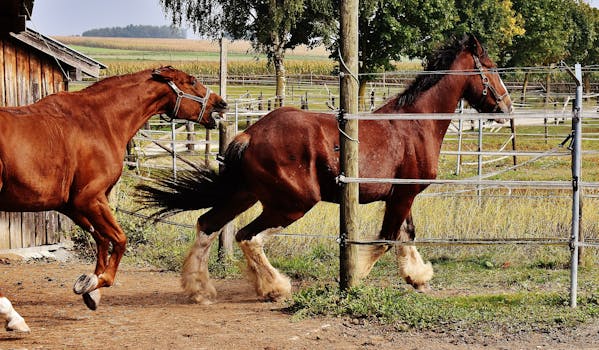 Whether you’re a beginner or a pro, horse behavior has signs we should all observe and understand. Insight to how a horse or your horse is feeling can be seen in their actions and behavior – much like humans.
Whether you’re a beginner or a pro, horse behavior has signs we should all observe and understand. Insight to how a horse or your horse is feeling can be seen in their actions and behavior – much like humans.
We all have things we don’t want to do, like go to work for example. We may linger at home for longer than necessary or walk with a bit of a slump if we are doing things that we don’t necessarily like or want to do.
Horse are the same. They may balk, flatten their ears against their head, swish their tails excessively/angrily, paw, stomp, pull back against their halter and lead, etc. These are all clear signs that a horse is scared, irritated, or angry.
There are extensive studies that have been done on human behavior – including what different stances in posture and body language can interprets to or mean. As with people, horse language can be interpreted by observing a few key elements in their behavior.
If you can not only read but respond to your horse’s body language on the ground and in the saddle, you are on your way to be a successful rider and trainer.
It’s All in the Ears
A horse’s ears are windows to how it is feeling. I am always watching my horse’s ears, particularly at events such as horse shows. My horse is a younger, spookier horse and there are some scary things at horse shows. I watch his ears to see if he is focused on anything behind us or in front of us. This can help the rider anticipate a horse fleeing or spooking away from a scary object.
Ears that are turned forward are focused on sights and sounds in front of him/her. Forward ears also display signs of interest – like if you are holding hay or treats in your hand. This is also a sign of curiosity. They may want to see what the foreign object or sound is as their interest increases.
Relaxed ears often rest to the side or may be slightly turned back. You may see this when a horse is resting or is completely relaxed or unimpressed with its surroundings at the moment. Relaxed ears may be a sign that your horse is not aware of its surroundings at the moment, so be sure to may a little bit of noise, shuffle your feet, or cluck before you approach so he/she is aware of your presence.
Pinned or flattened ears are a clear sign that your horse is not happy. Pinned ears are just that – ears that are not only turned back but seemed to be “flattened” against its head. Pinned ears can have several meanings and anyone nearby should proceed with caution so everyone can be safe. Some of the meanings of flattened ears may include:
- The horse is in pain or uncomfortable
- A sign of aggression
- Fear and considering fleeing
- A display of dominance – particularly in a herd setting
A horse’s ears are little gateways that give us humans a glimpse into what they are feeling. Flickering ears are a sign that they are alert and attentive or perhaps even overwhelmed by its environment in that moment.
Is your horse not paying attention? Trying to bolt? Refusing to move forward? Look at its ears – what are they telling you?
Legs Can Talk
A horse’s legs also display signs of how a horse is feeling. With four legs, there are plenty of options to show how a horse is reacting to a stimulus or how it feels about the current situation.
A “propped” hind leg is a sign of rest and relaxation. The horse has shifted it weight to another leg as it rests this one. This is similar to a human crossing their legs or standing splayed- with the weight on one leg while the other receives a break.
A raised, cocked back leg or one that is being kicked out is a clear sign that a horse is trying to either get away from something or trying to get the something away from it. This is usually accompanied by ears that are turned back either in irritation or fear. This can be potentially dangerous. Please use caution and do not approach the horse near its hind legs in this instance.
Pawing or striking with front legs are also horse behavior observations. There is a definite difference between pawing and striking.
 Striking is when a horse kicks forward with its front leg. This is a quick, forceful movement that can be used to keep other animals such as dogs or horses away from the horse if something has gotten to close to the front of the horse and it is defending itself.
Striking is when a horse kicks forward with its front leg. This is a quick, forceful movement that can be used to keep other animals such as dogs or horses away from the horse if something has gotten to close to the front of the horse and it is defending itself.
There are usually precursors to a strike – watch the ears and how your horse is responding to its environment. A strike can cause severe damage-and in rare instances-death.
Be extremely careful and educate yourself on both horse behavior and the body language of your horse.
Pawing is just that- the horse paws at the ground with one of its front legs. This is done when the horse is impatient or irritated or bored. Standing tied for log periods can trigger pawing, as can feeding time, stirring up the ground to create a soft spot to roll in, or can be a precursor to a charging another horse. It is generally not aggressive as striking but consider it as a warning to a larger reaction that could possibly occur.
Related Content:
Is Your Horse Lame? This Could be the Cause
Back to Basics – Horseback Riding Skills Every Rider Should Know
The Horse Behavior Secret Is….There is No Secret!
There isn’t a secret language only horse trainers know about horses. Anyone, anywhere can read horse behavior and body language. You just have to learn and then recognize the signs your horse is giving.
Another part to watch is a horse’s nose and mouth. A droopy lip can mean your horse is pretty relaxed and may be sleeping. If your horse has a constant drooping lip while awake and alert and is drooling you may want to schedule a vet appointment to get its teeth checked.
Foals “clack” their teeth as a sign of submission or warning. The foal will curl its lips back to reveal its teeth and click them together. It is an unusual sight and may alarm people at first, but it is quite normal. Horse behavior studies suggest that this is a sign of submission of a young foal. They are simply telling other horses to please not harm them. The video below is an example of teeth clacking so you can see.
Chewing (when not eating) and licking is a sign your horse is accepting what is happening in its environment and is comfortable and receptive. This is a good sign during training or when receiving treatments like chiropractic care. It means your horse is learning or saying “hey, that was pretty good.”
Horse body language is how a horse communicates with the outside world and with each other. Humans are very vocal and we generally express ourselves through speech.
A horse’s speech is it body language and movement. Click To TweetThey too can be vocal, but their primary way of communicating is through their body -ears, eyes, legs, head carriage, nose, etc.
The more time you spend around horses the easier the language will be to decipher. A horse displays signs of how it is feeling and has expressions just as people do. Continually observe horse behavior and its body language, and what once seemed so subtle may become crystal clear to you.
